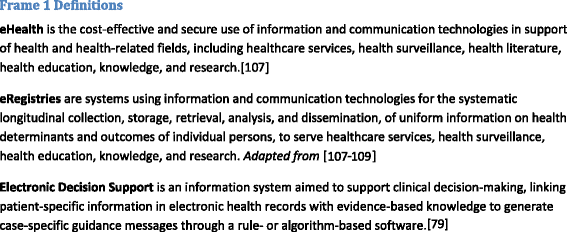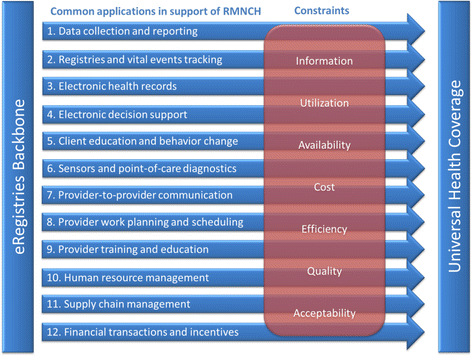eRegistries: Electronic registries for maternal and child health
- PMID: 26791790
- PMCID: PMC4721069
- DOI: 10.1186/s12884-016-0801-7
eRegistries: Electronic registries for maternal and child health
Abstract
Background: The Global Roadmap for Health Measurement and Accountability sees integrated systems for health information as key to obtaining seamless, sustainable, and secure information exchanges at all levels of health systems. The Global Strategy for Women's, Children's and Adolescent's Health aims to achieve a continuum of quality of care with effective coverage of interventions. The WHO and World Bank recommend that countries focus on intervention coverage to monitor programs and progress for universal health coverage. Electronic health registries - eRegistries - represent integrated systems that secure a triple return on investments: First, effective single data collection for health workers to seamlessly follow individuals along the continuum of care and across disconnected cadres of care providers. Second, real-time public health surveillance and monitoring of intervention coverage, and third, feedback of information to individuals, care providers and the public for transparent accountability. This series on eRegistries presents frameworks and tools to facilitate the development and secure operation of eRegistries for maternal and child health.
Methods: In this first paper of the eRegistries Series we have used WHO frameworks and taxonomy to map how eRegistries can support commonly used electronic and mobile applications to alleviate health systems constraints in maternal and child health. A web-based survey of public health officials in 64 low- and middle-income countries, and a systematic search of literature from 2005-2015, aimed to assess country capacities by the current status, quality and use of data in reproductive health registries.
Results: eRegistries can offer support for the 12 most commonly used electronic and mobile applications for health. Countries are implementing health registries in various forms, the majority in transition from paper-based data collection to electronic systems, but very few have eRegistries that can act as an integrating backbone for health information. More mature country capacity reflected by published health registry based research is emerging in settings reaching regional or national scale, increasingly with electronic solutions. 66 scientific publications were identified based on 32 registry systems in 23 countries over a period of 10 years; this reflects a challenging experience and capacity gap for delivering sustainable high quality registries.
Conclusions: Registries are being developed and used in many high burden countries, but their potential benefits are far from realized as few countries have fully transitioned from paper-based health information to integrated electronic backbone systems. Free tools and frameworks exist to facilitate progress in health information for women and children.
Figures



References
-
- Wilson K, Gertz B, Arenth B, Salisbury N. The journey to scale: moving together past digital health pilots. Seattle: PATH; 2014.
-
- WHO . Accountability for women’s and children’s health: report on progress to May 2014. Geneva: World Health Organization; 2014.
-
- Principles for digital development [http://digitalprinciples.org]. Accessed 15 Sept 2015.
-
- World Bank, USAID and WHO . The Roadmap for Health Measurement and Accountability. Washington, DC: MA4Health; 2015.
-
- Haazen DS, Slote (USAID/Global Health) Al-Shorbaji N, D’Adamo M. eHealth Technical Paper for MA4Health - Measurement and Accountability for Results in Health: A Common Agenda for the Post 2015 Era. Washington, DC: MA4Health; 2015.
MeSH terms
Grants and funding
LinkOut - more resources
Full Text Sources
Other Literature Sources
Medical
Miscellaneous

